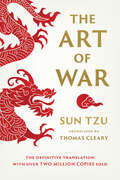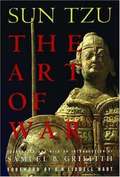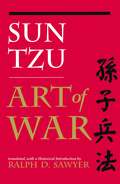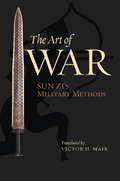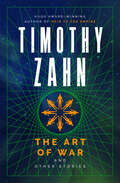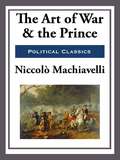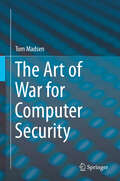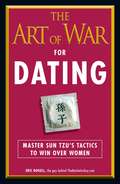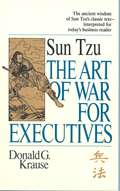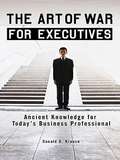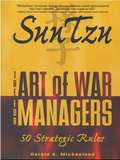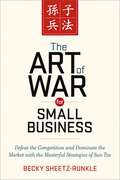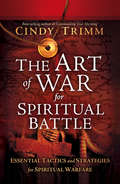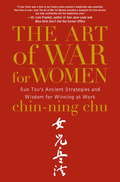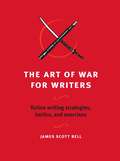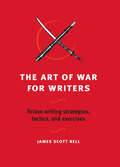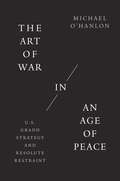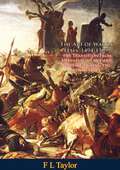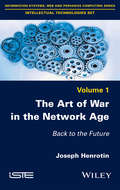- Table View
- List View
The Art of War (Skylight Illuminations Ser.)
by Sun Tzu Thomas ClearySun Tzu's Art of War, compiled more than two thousand years ago, is a study of the anatomy of organizations in conflict. It is perhaps the most prestigious and influential book of strategy in the world today. Now, this unique volume brings together the essential versions of Sun Tzu's text, along with illuminating commentaries and auxiliary texts written by distinguished strategists. The translations, by the renowned translator Thomas Cleary, have all been published previously in book form, except for The Silver Sparrow Art of War, which is available here for the first time. This comprehensive collection contains: The Art of War: This edition of Sun Tzu's text includes the classic collection of commentaries by eleven interpreters. Mastering the Art of War: Consisting of essays by two prominent statesmen-generals of Han dynasty China, Zhuge Liang and Liu Ji, this book develops the strategies of Sun Tzu's classic into a complete handbook of organization and leadership. It draws on episodes from Chinese history to show in concrete terms the proper use of Sun Tzu's principles. The Lost Art of War: Written more than one hundred years after Sun Tzu's text, by Sun Bin, a linear descendant of Sun Tzu, this classic of political and military strategy is faithful to the principles of The Art of War, while developing their practical application much further. The Silver Sparrow Art of War: A version of Sun Tzu's Art of War based on a manuscript of the classic text discovered at a Chinese archeological site in China's Shandong Province in 1972, which contains previously unknown fragments.
The Art of War
by Sun Tzu Samuel B. GriffithLike Machiavelli's The Prince and the Japanese Book of Five Rings, Sun Tzu's The Art of War is as timely for business people today as it was for military strategists in ancient China. Written in China more than 2,000 years ago, Sun Tzu's classic The Art of War is the first known study of theplanning and conduct of military operations. These terse, aphoristic essays are unsurpassed in comprehensiveness and depth of understanding, examining not only battlefield maneuvers, but also relevant economic, political, and psychological factors. Indeed, the precepts outlined by Sun Tzu regularlyapplied outside the realm of military theory. It is read avidly by Japanese businessmen and was touted in the movie Wall Street as the corporate raider's bible. Providing a much-needed translation of this classic, Samuel Griffith has made this powerful and unique work even more relevant to the modern world. Including an explanatory introduction and selected commentaries on the work, this edition makes Sun Tzu's timeless classic perfectly accessible tomodern readers.
The Art of War: Sun Tzu/sun Pin
by Sun Tzu Ralph D SawyerThe Art of War is almost certainly the most famous study of strategy ever written and has had an extraordinary influence on the history of warfare. The principles Sun-tzu expounded were utilized brilliantly by such great Asian war leaders as Mao Tse-tung, Giap, and Yamamoto. First translated two hundred years ago by a French missionary, Sun-tzu's Art of War has been credited with influencing Napoleon, the German General Staff, and even the planning for Desert Storm. Many Japanese companies make this book required reading for their key executives. And increasingly, Western businesspeople and others are turning to the Art of War for inspiration and advice on how to succeed in competitive situations of all kinds. Unlike most editions of Sun-tzu currently available (many simply retreads of older, flawed translations), this superb new translation makes use of the best available classical Chinese manuscripts, including the ancient "tomb text" version discovered by archaeologists at Linyi, China. Ralph Sawyer, an outstanding Western scholar of ancient Chinese warfare and a successful businessman in his own right, places this classic work of strategy in its proper historical context. Sawyer supplies a portrait of Sun-tzu's era and outlines several battles of the period that may have either influenced Sun-tzu or been conducted by him. While appreciative of the philosophical richness of the Art of War, this edition stresses Sun-tzu's practical origins and presents a translation that is both accurate and accessible.
The Art of War: Sun Zi's Military Methods (Translations from the Asian Classics)
by Sun ZiCompiled during the Warring States period of 475-221 B.C.E., The Art of War has had an enormous impact on the development of Chinese military strategy over the past two thousand years and occupies an important place in East Asian intellectual history. It is the first known attempt to formulate a rational basis for the planning and conduct of military operations, and while numerous editions of the work exist, Victor Mair's translation is the first to remain true to the original structure and essential style of the text. <P><P>Mair's fidelity to the original, along with his insightful commentary and reliance on archaeologically recovered manuscripts, breaks new ground in solving The Art of War's difficult textual and contextual problems. He confronts complex questions concerning the authorship of the work, asserting that Sun Wu, a supposed strategist of the Spring and Autumn period (770-476 B.C.E.) to whom the text is traditionally attributed, never existed. Instead, Mair claims that The Art of War coalesced over a period of around seventy-five years, from the middle of the fourth century to the first quarter of the third century B.C.E. Mair also reveals the way The Art of War reflects historical developments in technological and military strategy in civilizations throughout Eurasia, especially in regards to iron metallurgy. He demonstrates the close link between the philosophy in The Art of War and Taoism and discusses the reception of the text from the classical period to today. <P><P> Finally, Mair highlights previously unaddressed stylistic and statistical aspects and includes philological annotations that present new ways of approaching the intellectual and social background of the work. A phenomenal achievement, Mair's comprehensive translation is an indispensable resource for today's students, strategists, and scholars.
The Art of War and Other Chinese Classics
by VariousA compilation of Chinese Classics including The Art of War by Sun Tzu, The Sayings of Lao Tzu translated by Lionel Giles, and I Ching translated by James Legge
The Art of War and Other Stories
by Timothy ZahnEscape to far-off planets with ten science fiction stories from the #1 New York Times–bestselling author of the Star Wars Thrawn trilogy. Contains two original stories: &“The Needs of the Many&” and &“Challenge Accepted&” Hugo Award–winning author Timothy Zahn presents an original collection of science fiction adventure stories. Some of the works here were previously printed in publications such as The Magazine of Fantasy & Science Fiction and Analog,or in themed collections, but have never appeared together until now . . .The Shadow Stories In &“The Shadows of Evening,&” a seasoned warrior named Turek has dedicated his life to defending colonists from mysterious and debilitating Shadows on a hostile planet. Zahn elaborates Turek&’s story with two sequels, and now concludes the saga with the original story, &“The Needs of the Many.&”The Hive Mind Stories Two Hive Mind starcraft observe Earth from afar and from a superior viewpoint in &“The Challenge.&” They believe that self-destructive competition among humans will prevent this so-called fragmented race from achieving the technological level required to reach the stars. In two sequels, Zahn explores what would happen if humans found a different way to the heavens. Now, with the original story &“Challenge Accepted,&” he brings the series to a climactic end. Two more stories round out the collection. In &“Star Song,&” humans find a unique way to fuel interstellar travel with music, while a diplomatic aide gets caught up in a plot of greed and destruction in &“The Art of War.&” Together, these ten tales promise action, adventure, humor, and more, all from the masterful mind of one science fiction&’s greatest authors.
The Art of War and the Prince
by Niccolo MachiavelliCollected here in one omnibus edition are Niccolò Machiavelli's most import works, The Art of War and The Prince. It was Niccolò Machiavelli who essentially removed ethics from government. He did it with The Prince, when he asserted that The Prince (president, dictator, prime minister, etc.) does not have to be concerned with ethics, as long as their motivation is to protect the state. It is this questionable belief that in many ways had lead to the modern world as we know it. His assertion was that the head of state must protect the state no matter the cost and no matter what rules he or she breaks in the process. If you want to understand modern politics you must read this book. Machiavelli considered The Art of War his greatest achievement. Here you will learn how to recruit, train, motivate, and discipline an army. You will learn the difference between strategy and tactics. Machiavelli does a masterful job of breaking down and analyzing historic battles. This book of military knowledge belongs alongside Sun-Tzu and Clausewitz on every book shelf.
The Art of War for Computer Security
by Tom MadsenIn this book the author draws inspiration from Sun Tzu's Art of War, a work that explains conflict between nations, and he applies this to the computer security setting, examining how we should consider protecting information systems from accidents or malicious attacks. The author first briefly introduces Sun Tzu. Then each chapter in the book takes its inspiration from an original title in The Art of War, where the author offers a general introduction to the content and then describes its application in a cybersecurity setting. These chapters cover estimates; waging war; offensive strategy; how you prepare for an attack; energy; weaknesses and strengths; the variables that need consideration before embarking on a war; how infrastructure is related to the concept of ground; attack by fire or how skilled attackers hide behind noise; and employing secret agents. The book will be interesting for computer security researchers and professionals who would like some grounding in a security mindset.
The Art of War for Dating
by Eric RogellFor centuries, man has studied the ancient art of war before heading into battle--obsessively planning, strategically theorizing, and meticulously executing. If only he did that before trying to pick up women.Just as they turn to Sun Tzu's honored text for military guidance, they can sharpen their dating skills by adapting the good general's advice. But since every guy hitting the bar on Saturday night isn't a seasoned warrior, this book has done the heavy lifting. By dissecting Sun Tzu's original text, extracting his core wisdom, and applying it to picking up women, this book teaches you how to win the battle of the sexes.A woman might not be an enemy to conquer--but she is a prize to win over.
The Art of War for Dating
by Eric RogellFor centuries, man has studied the ancient art of war before heading into battle--obsessively planning, strategically theorizing, and meticulously executing. If only he did that before trying to pick up women.Just as they turn to Sun Tzu's honored text for military guidance, they can sharpen their dating skills by adapting the good general's advice. But since every guy hitting the bar on Saturday night isn't a seasoned warrior, this book has done the heavy lifting. By dissecting Sun Tzu's original text, extracting his core wisdom, and applying it to picking up women, this book teaches you how to win the battle of the sexes.A woman might not be an enemy to conquer--but she is a prize to win over.
The Art of War for Executives: Sun Tzu's Classic Text Interpreted for Today's Business Reader
by Donald G. KrauseFor years, business schools and professional consultants have turned to Sun Tzu's 2,500-year-old Chinese text for its invaluable commentary on such topics as leadership, strategy, organisation, competition and cooperation. Now the wisdom of Sun Tzu's The Art of War is made accessible to the modern reader. Not simply a new translation, this is the first book to provide a clear, easy-to-follow interpretation of the classic document. The Art of War for Executives reveals the brilliance of Sun Tzu - and shows how to win on the battlefield of modern business. The tone and insight of the original classic remain, whilst incorperating the ideas of contemporary business philosophers, like Peters, Drucker and Bennis. Here at last is an accessible interpretation of Sun Tzu's The Art of War incorperating modern business lessons to make this classic text relevant and readable for today's executive facing strategic and competitive challenges.
The Art of War for Executives
by Krause Donald G.The first book to provide a clear easy-to-follow interpretation of Sun Tzu's classic document. The Art of War for Executives shows how to win on the battlefield of business.
The Art Of War For Managers: Fifty Strategic Rules
by Gerald A. MichaelsonReaders will learn the strategic rules of Sun Tzu and how to incorporate them into their management style. in this translation of the Art of War readers will benefit from the interpretations from other translators and strategist, as well as the 50 strategic rules.
The Art of War for Small Business: Defeat the Competition and Dominate the Market with the Masterful Strategies of Sun Tzu
by Becky Sheetz-RunkleSun Tzu's ancient The Art of War has inspired military, political, and business leaders across the world with its brilliant strategies for prevailing against opponents. At the core of this classic treatise is the message that sledgehammer approaches can backfire, and size alone does not guarantee wins. Strategy, positioning, planning, leadership--all play equally significant roles, making Sun Tzu's teachings perfect for small business owners and entrepreneurs entrenched in fierce competition for customers, market share, talent . . . for their very survival. The Art of War for Small Business is the first book to apply Sun Tzu's wisdom to the small business arena. Featuring inspiring examples of entrepreneurial success, the book's 12 timeless lessons reveal how to: Choose the right ground for your battles Prepare without falling prey to paralysis Leverage strengths while overcoming limitations Strike competitors' weakest points and seize every opportunity Focus priorities and resources on conquering key challenges Go where the enemy is not Build and leverage strategic alliances Big companies may deploy overwhelming forces, but small companies can outsmart, outmaneuver, and outstrategize larger adversaries to capture crucial sectors, serve unmet needs, and emerge victorious.
The Art of War for Spiritual Battle: Essential Tactics and Strategies for Spiritual Warfare
by Cindy TrimmThis new book by best-selling author Cindy Trimm, The Art of War for Spiritual Battle will become the &“go-to&” manual for preparing Christians to have victory in today&’s spiritual battles with the enemy through strategic spiritual warfare and powerful intercessory prayer. Using occasional relevant quotes from the classic book, The Art of War by Sun Tzu, long a manual of wisdom for handling conflict of any kind, Trimm teaches the necessary disciplines for a modern-day prayer warrior. The principles in this book include tactics for organizing prayer, protocols for enforcing your authority as you wage your prayer campaign, and strategies for establishing and expanding God&’s kingdom wherever you are.
The Art of War for Women
by Chin-Ning ChuForget everything you think you know about strength, strategy and success. This brilliant adaptation of the ancient masterpiece The Art of War shows women how to use Sun Tzu's philosophy to win in every aspect of life.Would you like to transform your weaknesses into strengths? Succeed at work without compromising your ethics? Integrate your style and personal philosophy into every action you take? If so, this book is for you. In The Art of War for Women, bestselling author Chin-Ning Chu brings the eternal wisdom of philosopher-general Sun Tzu to women looking to gain a better understanding of who they are - and, more importantly, who they want to be. In the West, when we think of war, we imagine battle, casualties, brutality. But Sun Tzu, the man who wrote the Art of War some 2,500 years ago, was Chinese, and the Chinese think of war differently than we do in the West. In their view, war does not revolve around fighting. It is about determining the most efficient way of gaining victory with the least amount of conflict.That's why Sun Tzu's Art of War is particularly appropriate for women. Let's face it, as intelligent and accomplished as we may be, there are very few of us who are comfortable with direct confrontation or situations where our triumph means someone else's defeat. We are natural negotiators and problem solvers; most of us prefer win-win situations to those in which winner-takes-all.But there is another reason The Art of War is particularly appropriate for us. Although Sun Tzu's book is about the application of strategies, every one of those strategies begins with having a deep understanding of the people and the world around us. They also require us to understand ourselves - our strengths and weaknesses, our goals and fears. In other words, the aim is not to apply a series of rules coldly and dispassionately, but rather to integrate ourselves and our unique talents into the strategies we will employ. This is not a feel-good book. (But you will feel good after reading it.) It is not a motivational book. (But you will be motivated to achieve what you want, once you are done.) Ultimately, its purpose it to provide women with the strategies we all need to overcome the obstacles that stand in the way of our goals and dreams. Sun Tzu's Art of War is the most influential book on strategy ever published, selling tens of millions of copies worldwide in several editions. Written by one of today's foremost authorities on Sun Tzu, The Art of War for Women is sure to become a classic in its own right.
The Art of War for Women: Sun Tzu's Ancient Strategies and Wisdom for Winning at Work
by Chin-Ning ChuForget everything you think you know about strength, strategy and success. This brilliant adaptation of the ancient masterpiece The Art of War shows women how to use Sun Tzu's philosophy to win in every aspect of life.Would you like to transform your weaknesses into strengths? Succeed at work without compromising your ethics? Integrate your style and personal philosophy into every action you take? If so, this book is for you. In The Art of War for Women, bestselling author Chin-Ning Chu brings the eternal wisdom of philosopher-general Sun Tzu to women looking to gain a better understanding of who they are - and, more importantly, who they want to be. In the West, when we think of war, we imagine battle, casualties, brutality. But Sun Tzu, the man who wrote the Art of War some 2,500 years ago, was Chinese, and the Chinese think of war differently than we do in the West. In their view, war does not revolve around fighting. It is about determining the most efficient way of gaining victory with the least amount of conflict.That's why Sun Tzu's Art of War is particularly appropriate for women. Let's face it, as intelligent and accomplished as we may be, there are very few of us who are comfortable with direct confrontation or situations where our triumph means someone else's defeat. We are natural negotiators and problem solvers; most of us prefer win-win situations to those in which winner-takes-all.But there is another reason The Art of War is particularly appropriate for us. Although Sun Tzu's book is about the application of strategies, every one of those strategies begins with having a deep understanding of the people and the world around us. They also require us to understand ourselves - our strengths and weaknesses, our goals and fears. In other words, the aim is not to apply a series of rules coldly and dispassionately, but rather to integrate ourselves and our unique talents into the strategies we will employ. This is not a feel-good book. (But you will feel good after reading it.) It is not a motivational book. (But you will be motivated to achieve what you want, once you are done.) Ultimately, its purpose it to provide women with the strategies we all need to overcome the obstacles that stand in the way of our goals and dreams. Sun Tzu's Art of War is the most influential book on strategy ever published, selling tens of millions of copies worldwide in several editions. Written by one of today's foremost authorities on Sun Tzu, The Art of War for Women is sure to become a classic in its own right.
The Art of War for Women: Sun Tzu's Ancient Strategies and Wisdom for Winning at Work
by Chin-Ning ChuForget everything you think you know about strength, strategy and success. This brilliant adaptation of the ancient masterpiece The Art of War shows women how to use Sun Tzu’s philosophy to win in every aspect of life.Would you like to transform your weaknesses into strengths? Succeed at work without compromising your ethics? Integrate your style and personal philosophy into every action you take? If so, this book is for you. In The Art of War for Women, bestselling author Chin-Ning Chu brings the eternal wisdom of philosopher-general Sun Tzu to women looking to gain a better understanding of who they are--and, more importantly, who they want to be. Although Sun Tzu’s book is about the application of strategies and determining the most efficient way of gaining victory with the least amount of conflict, every one of those strategies begins with having a deep understanding of the people and the world around us. They also require us to understand ourselves--our strengths and weaknesses, our goals and fears. In other words, the aim is not to apply a series of rules coldly and dispassionately, but rather to integrate ourselves and our unique talents into the strategies we will employ. This is not a feel-good book. (But you will feel good after reading it.) It is not a motivational book. (But you will be motivated to achieve what you want, once you are done.) Ultimately, its purpose it to provide women with the strategies we all need to overcome the obstacles that stand in the way of our goals and dreams. Sun Tzu’s Art of War is the most influential book on strategy ever published, selling tens of millions of copies worldwide in several editions. Written by one of today’s foremost authorities on Sun Tzu, The Art of War for Women is sure to become a classic in its own right.From the Trade Paperback edition.
The Art of War for Women: Sun Tzu's Ancient Strategies and Wisdom for Winning at Work
by Chin-Ning ChuForget everything you think you know about strength, strategy and success. This brilliant adaptation of the ancient masterpiece The Art of War shows women how to use Sun Tzu's philosophy to win in every aspect of life. Would you like to transform your weaknesses into strengths? Succeed at work without compromising your ethics? Integrate your style and personal philosophy into every action you take? If so, this book is for you. In The Art of War for Women, bestselling author Chin-Ning Chu brings the eternal wisdom of philosopher-general Sun Tzu to women looking to gain a better understanding of who they are and, more importantly, who they want to be. In the West, when we think of war, we imagine battle, casualties, brutality. But Sun Tzu, the man who wrote the Art of War some 2,500 years ago, was Chinese, and the Chinese think of war differently than we do in the West. In their view, war does not revolve around fighting. It is about determining the most efficient way of gaining victory with the least amount of conflict. That's why Sun Tzu's Art of War is particularly appropriate for women. Let's face it, as intelligent and accomplished as we may be, there are very few of us who are comfortable with direct confrontation or situations where our triumph means someone else's defeat. We are natural negotiators and problem solvers; most of us prefer win-win situations to those in which winner-takes-all. But there is another reason The Art of War is particularly appropriate for us. Although Sun Tzu's book is about the application of strategies, every one of those strategies begins with having a deep understanding of the people and the world around us. They also require us to understand ourselves - our strengths and weaknesses, our goals and fears. In other words, the aim is not to apply a series of rules coldly and dispassionately, but rather to integrate ourselves and our unique talents into the strategies we will employ. This is not a feel-good book. (But you will feel good after reading it.) It is not a motivational book. (But you will be motivated to achieve what you want, once you are done.) Ultimately, its purpose it to provide women with the strategies we all need to overcome the obstacles that stand in the way of our goals and dreams. Sun Tzu's Art of War is the most influential book on strategy ever published, selling tens of millions of copies worldwide in several editions. Written by one of today's foremost authorities on Sun Tzu, The Art of War for Women is sure to become a classic in its own right.
The Art of War for Writers: Fiction Writing Strategies, Tactics, and Exercises
by James Scott BellStrategies and Tactics for the Master NovelistSuccessfully starting and finishing a publishable novel is often like fighting a series of battles. You not only have to work hard to shape memorable characters, develop gripping plots, and craft dazzling dialogue, but you also have to fight against self-doubts and fears. And then there's the challenge of learning to navigate the ever-changing publishing industry.That's why best-selling novelist James Scott Bell, author of the Write Great Fiction staples Plot & Structure and Revision & Self-Editing, came up with the ultimate novel-writing battle plan: The Art of War for Writers.You'll find tactics and strategies for idea generation and development, character building, plotting, drafting, querying and submitting, dealing with rejection, coping with unrealistic expectations, and much more.With timeless, innovative, and concise writing reflections and techniques, The Art of War for Writers is your roadmap to victory.
The Art of War for Writers: Fiction Writing Strategies, Tactics, and Exercises
by James Scott BellStrategies and Tactics for the Master NovelistSuccessfully starting and finishing a publishable novel is often like fighting a series of battles. You not only have to work hard to shape memorable characters, develop gripping plots, and craft dazzling dialogue, but you also have to fight against self-doubts and fears. And then there's the challenge of learning to navigate the ever-changing publishing industry.That's why best-selling novelist James Scott Bell, author of the Write Great Fiction staples Plot & Structure and Revision & Self-Editing, came up with the ultimate novel-writing battle plan: The Art of War for Writers.You'll find tactics and strategies for idea generation and development, character building, plotting, drafting, querying and submitting, dealing with rejection, coping with unrealistic expectations, and much more.With timeless, innovative, and concise writing reflections and techniques, The Art of War for Writers is your roadmap to victory.
The Art of War in an Age of Peace: U.S. Grand Strategy and Resolute Restraint
by Michael O'HanlonAn informed modern plan for post-2020 American foreign policy that avoids the opposing dangers of retrenchment and overextension Russia and China are both believed to have “grand strategies”—detailed sets of national security goals backed by means, and plans, to pursue them. In the United States, policy makers have tried to articulate similar concepts but have failed to reach a widespread consensus since the Cold War ended. While the United States has been the world’s prominent superpower for over a generation, much American thinking has oscillated between the extremes of isolationist agendas versus interventionist and overly assertive ones. Drawing on historical precedents and weighing issues such as Russia’s resurgence, China’s great rise, North Korea’s nuclear machinations, and Middle East turmoil, Michael O’Hanlon presents a well†‘researched, ethically sound, and politically viable vision for American national security policy. He also proposes complementing the Pentagon’s set of “4+1” pre†‘existing threats with a new “4+1”: biological, nuclear, digital, climatic, and internal dangers.
The Art of War in Italy, 1494-1529: the Transition From Mediaeval to Modern Warfare During the Renaissance
by F L Taylor“The birth of 'New War' in ItalyIt is easy to consider the Renaissance as a time of enlightenment typified principally by the artistic and scientific genius of Leonardo da Vinci and his peers; but giant leaps forward are never confined to one aspect of society and the application of new ideas is always adapted to various purposes and the meeting of differing objectives. The creation of modern political science by Niccolo Machiavelli is a prime example of how new ways of thinking and doing impacted on the advancement and securing of power. These changes were inevitably accompanied by significant developments in making war more effectively, strategically and tactically-with corresponding advances in weaponry and other equipage. This excellent book considers these developments through the changes to traditional military strategy and the use of infantry, cavalry and artillery, in both open battle and fortification and siege-craft, at the turn of the sixteenth century.”-Print ed.
The Art of War in the Middle Ages A.D. 378-1515: A. D. 378-1515 (classic Reprint) (The World At War)
by C. W. C. OmanThis history of medieval warfare, originally written in 1885 when its author later one of the great medievalists was still an undergraduate at Oxford, remains for students and general readers one of the best accounts of military art in the Middle Ages between Adrianople in 378 A.D. (the most fearful defeat suffered by a Roman army since Cannae in 216 B.C.) and Marignano (1515 A.D.), the last of the triumphs of the medieval horseman. (Goodreads)
The Art of War in the Network Age: Back to the Future
by Joseph HenrotinExamining the influence of information technology on the art of war theoretical structure and, beyond, the concrete effects of those technologies on the conduct of war (thus, not warfare) itself. What could be the influence of information technology on the art of war theoretical structure and, beyond, what are the concrete effects of those technologies on the conduct of war itself? "Art build upon a science", strategy is often forgotten by publications dealing with the impacts of technology on warfare, but are network-centric warfare and all those technological artefacts really a revolution for war? The interaction of theoretical strategy and information networks has not really been systematically treated before this book.
